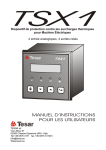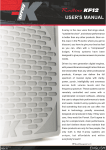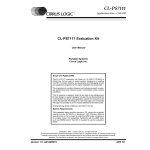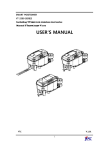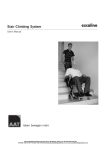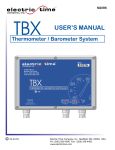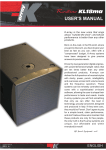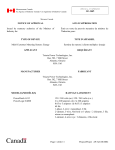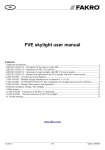Download manuale TSX1 inglese.cdr
Transcript
TSX1 Thermal protection device for electric units 4 analog input channels, 4 output relays USER’S MANUAL TESAR srl 52000 Chiassa Superiore (AR) - Italy Tel +39 0575 3171 fax +39 0575 317201 [email protected] www.tesar.eu Introduction Congratulations for your choice to purchase TSX1, the electronic device for temperature monitoring. This manual gives you the information you need when you install and configure the TSX1 device. For a useful usage of this manual, we suggest you to read it standing near to the TSX1 device to directly verify the instructions. Device Overview The TSX1 device comes into begin to satisfy the insulated resin transformers or dry type transformers user's requirements. In details the TSX1 device characteristics are: — 4 analog input channels for resistive probes Pt100 to measure 4 temperatures: the temperatures in the three transformer columns and the one in the core (see figure below). — backlighted LCD display 16 characters x 2 lines, for the visualization of all the 4 measured temperatures. In this way we obtain the whole temperature situation in only one visualization. — Membrane keyboard with 4 keys to program setup parameters. — Non volatile data storage. — 4 output relays to perform 3 alarm levels equal for all the inputs, and a general alarm to signal operation anomalies in the device or in the probes. The 3 alarm levels are useful to drive fans, external signalings (as lights or sirens), and the unhook of the electric unit from the electrical line. The system performs useful reading of the measured temperatures and a very easy definition of the control parameters. The TSX1 device has been realized compliance with the electromagnetic compatibility requirement. Probe D Probe A 2 Probe B Probe C Technical specifications Power supply — — — — — nominal line voltage and frequency: 24 ÷ 250 Vcc and Vac at 40 ÷ 60 Hz Maximum line voltage from 20 to 260 Vcc and Vac Vcc with reversible polarity Maximum power absorption 7 VA Protection against electrical and magnetic noises Inputs — 4 analog input channels for three wires Pt100 probes compliance with requirement DIN 43760. The operator can de-activate the 4th channel from programming — connection with removable terminals for wires of 1,5 mm2 section — cables length compensation up to 500 m (1 mm2 section) — detection for broken or not connected probes — input channels protected against electromagnetic noises and spikes Outputs — 4 output relays with contacts capacity of 5A with 250Vac - one relay for the 1st setpoint level (for fan control) - one ralay for the 2nd setpoint level (pre-alarm) - one relay for the 3rd setpoint level (unhook of the electrical unit) - one relay for probe fault or working anomaly signaling (general alarm) — output connection with removable terminals for wire of 1,5 mm2 section and capacity of 8A/250 Vac Device dimensions — frontal dimension 96 mm x 96 mm compliance with DIN 43700 requirements. Device length of 105 mm with rear terminals — assembling on the front of the electric panel — panel cut-out 92 mm x 92 mm — ABS self-extinguishing container — Frontal panel in anti-scratch polyestere with keyboard and signal leds Performances — — — — — — — — — — Temperature monitoring from 20°C to 200°C Temperature measurements accuracy ±0,5% full scale, ±1 digit Digital linearity of probe signal compliance with DIN 43760 requirements Self-diagnostics Operating temperature range from 5°C to 50°C Humidity lower then 95% no-condensing Compliance with CE requirement User data storage for 10 years without power supply Device functionality self-diagnostic Alarm signal for working anomalies or wrong user data definition Displaying and data management — backlighted LCD display 16 characters x 2 lines, for the visualization of all the 4 measured temperatures — 3 leds indicating alarm levels — 1 led indicating working anomalies or probe fault — user data programming by membrane keypad — automatic exit from programming procedure after 30 seconds of no operation — 3 temperature levels programming for 3 input channels — 3 temperature levels programming for the 4 input channel — hysteresis, alarm memory, delay and impulse data programming — notification for wrong user data statements — stated data recall and visualization by the membrane keypad — maximum measured temperature storage for each input channel — memory alarm reset by membrane keypad Cautions — avoid power supply out of the device nominal range — use shielded cables for the probes — avoid the device working in room with conditions out of the nominal ones previously reported and in particular in presence of condensing humidity. Device and accessories description The Figure represents the scheme of the device. Frontal panel 1. Backlighted LCD display 16 characters per 2 lines. It allows the simultaneous visualization of the measured temperatures. It is possible to visualize and modify the alarm sets using the keys. 2. Leds A1, A2, A3 point out the corresponding alarm activation due to the exceeding of the alarm sets by one of the measured temperatures. 3. General Alarm led points out anomalies. This led lights up in these cases: - The self-diagnostics program pointed out an anomaly - There is a damaged or not connected probe - The system is in no-active control (data programming modality) 4. Second function v key. Pressed with the confirming key (7) it allows to enter the programming modality; in this modality it allows the shift on number to be modified. 5. Decrease u key. Out of the programming modality it allows the navigation in the data visualization pages. In the programming modality it allows to decrease the value of the programming datum. 6. Increase t key. Out of the programming modality it allows the navigation in the data visualization pages. In the programming modality it allows to increase the value of the programming datum. 7. Confirming å key. In the programming modality it confirms the set datum. TSX1 1 3 2 A1 A2 A3 7 4 5 6 front view 3 Back panel and accessories 1. Connector for probes connection 2. Connector for the relay outputs 3. Power supply connector 1 1 2 2 3 3 A 13 13 14 14 15 15 16 16 17 17 4 4 5 5 6 6 18 18 7 7 19 19 B A1 4 A2 8 8 20 20 9 9 21 21 10 10 22 22 25 25 11 11 23 23 26 26 24 24 27 27 12 12 C D A3 5 3 2 1 Rear view and accessories 4. Removable terminals for the wiring harness 5. Clips for the device clamping. Mechanical installation 24,54 mm 95 mm 105 mm A1 A2 A3 96 mm 26,32 mm 24,27 mm 92 mm TSX1 26,32 mm 96 mm 24,03mm mm 89,5 x 87,5 The TSX1 device provides a black self-extinguishing ABS container. The device 92 mm 24,27 mm 27,01 mm dimensions are compliance to the standard of DIN 43700: 96 mm x 96 mm section and a maximum depth of 105 mm. The dimensions of the panel perforation are 92 mm x 92 mm. The fixing is carried out using the clamps provided with the device. 4 Electrical connections All the connections are carried out with the removable terminals provided with the device for a simplified wiring harness. For the wiring harness you can refer to the figure 5 and to the terminals numeration. Power Supply The power supply connection is performed connecting the power voltage to the terminals 25 and 27 without any respect of polarity for Vcc. The nominal allowed voltages are in the 24 Vcc 240 Vcc range for the direct voltage, or in the 24 Vca 240 Vca range with 50 Hz frequency for the alternate voltage. Terminal 26 has to be connected to the ground reference. The device power supply is protected from momentary input over-voltages. The damage due to a wrong power supply is not covered by guarantee. The device does not provide internal fuses, so that you must provide an external adequate protection. Relays outputs connection Figure 5 shows the position of the relays not excited (turned off device). The alarm relays are excited when one of the probes exceeds the set limit. The General Alarm relay operates in intrinsic security, so that it is excited at the device switching on, and it is de-excited when conditions that compromise the device functionality take place. In this way when the device is switched off you have the noactive control signal. Relays test 1 3 2 probe A 4 5 6 probe B 7 8 9 10 11 12 probe D probe C input probes Pt100 13 15 14 A1 16 17 A2 18 19 20 21 22 23 24 General allarm A3 output relays red red white probe Pt100 25 26 27 power supply As reported in figure at the right side, when device start-up, you can access to the relays test page pushing key. Pushing the last key on the left, ralay 1 (RL1) will be excited, the associated led will be lighted up. Pushing the second key, relay 2 (RL2) will be excited, the respective led will be lighted up and so on. Pushing the key of an excited relay, this stop to be excited. On display you can see a decreasing counter: this counter will be resetted at every relays TEST RELAY XXX commutation. When the counter reach zero value, RL1 RL2 RL3 RL4 device will be switched on normal running to avoid 5 that the relays test still switched on in case of oversight. The counter is useful to inform when the test will be over. Probes connection The analog inputs are compatible with three wires Pt100 resistive probes. For the sensors connection we suggest jumper you the following expedients: — use a shielded cable to connect the probe with the device and with the shield fixed to the ground reference 1 2 3 3 1 2 inside the electric panel 3 wires probe 2 wires probe — the connection cables route has to be separated from the high-tension cables and from cables driving inductive elements as remote-control switch — the 3 wires of each probe will have the same length and section so that they have all the same line resistance. The line resistance will be lower than 10 W, corresponding to a wire of 500 meters length and 1 mm2 section. It is also possible to use 2 wires Pt100 probes making a link on the terminals for the line resistance measure, as shown in figure. In that case the temperature's measure will be affected by an error as large as longer is the probe connection cable. Instructions for use Visualization and keyboard use On the TSX1 device the measured temperatures and the set data visualization is done by the navigation on pages by keyboard. Besides this kind of visualization has a very intuitive use, it allows the simultaneous visualization of data related to the same ambit. Navigation on pages Navigation on visualization pages takes place using the increase and decrease keys referred to with t and u symbols. Pages are cyclically placed: when you arrive to the last page you directly go to the first one. Referring to the scheme, with the key u you run the pages clockwise, whereas with the key t you run the pages anticlockwise. The usually visualized page is page 1, which is the principle one. It shows the temperatures measured by the probes. The device visualizes this page at the switching on and every time it is standing for a time greater than 30 seconds (no key pushed). Page 2 visualizes the maximum values of temperatures measured by each probe. Page 3 visualizes the three alarm levels setpoints programmed for probes A, B and C. Page 4 visualizes the three alarm levels setpoints programmed for probe D. If lines appear instead of numbers, it means that the D probe has been de-activated by 1 A 888° C 888° B 888° D 888° 9 2 MAX A 888°B 888° C 888°D 888° LIGHT ALWAYS ON? YES/NO 8 LANGUAGE? ITA ENG FRA DEU 7 CONTRAST REGULATION set ABC A2 888° set D A2 888° DEFAULT DATA ? YES/NO 6 HYS 88° IMP 88s DEL 88s AUT 0 5 A1 888° A3 888° A1 888° A3 888° 3 4 ENABLE PROBE D ? YES/NO 4b 6 programming. Entering the programming modality from this page, you go to page 4b that allows the activation or de-activation of the D probe. Page 5 visualizes the hysteresis, delay, alarm memory and impulsive release data. Page 6 provides the loading of the data set usually fornished with the device. Page 7 gives access to the display contrast regulation. Page 8 gives access to the language selection. In page 9 you can choose the operation of the display backlighting: always or limited-time alight. Programming The programmable data can be modified following a procedure, later on described, that allows to intuitively set data in little groups. Data are visualized collected in pages as described in the previous paragraph. To modify one of these groups you must follow the next procedure: — using t and u keys (as indicated in the previous paragraph) you can choose the visualization page containing the data to be programmed — simultaneously pushing v and å keys you can enter the programming modality. In the programming modality, according to the data group, either a guided page with specific questions or the same page with a flashing cursor standing on a cipher of the first datum to be modified, appears. The programming modality entry is easily recognizable, because also the General Alarm led blinks to signal that the device is no more in the active-control modality. Once you entered the programming modality, a flashing cursor appears on one of the visualized data. Using t and u keys it is possible to increase, decrease or anyway modify. For numerical data it is possible to shift the cursor to the next cipher pushing the v key. The shift is cyclical: keeping on pushing the v key you pass through all the datum ciphers and after the last one you return to the initial one. This is usefull to correct erroneous sets. When the datum definition is completed, you must confirm it pushing the å key and the cursor will shift on a cipher of the next datum. If you don't want to modify the datum it's sufficient to confirm it pushing the å key. Once you have confirmed the last programmable data of the visualized page, the device carries out a conformity test of the set data: if the test is positive, the set data are storaged and the device leaves the programming modality and returns to the usual visualization modality. If the data test is negative an error signal appears and the device doesn't leave the programming modality showing the same page to correct data. The exit from the programming modality can occur also for inactivity, if nobody pushes a key for at least 30 seconds. In that case the device ignores the data modifications eventually done and restores data set before entering the programming modality. 7 You have to program even not numerical data using the t and u keys and confirm them by the å key. A brief description of each page programming follows: — in page 2 of in the programming modality, simultaneously pushing the v and the å keys, you can modify the maximum temperatures reached by each acquisition channel. You can only put these data at zero. Entering the programming modality the four maximum values will be simultaneously put at zero. Anyway you won't see zeros because the device, once you have finished the zero setting, will do a comparison with the measured temperatures that will surely be greater so that the maximum values will immediately be updated. — in page 3 of in the programming modality, simultaneously pushing the v and the å keys, you can modify the temperature levels relative to the three A, B and C probes alarms. The data modification modality is the general one described above. The A1 threshold is the first alarm level, the A2 threshold is the second one and the A3 one is the last level (transformer's uncoupling). — in page 4 of in the programming modality, simultaneously pushing the v and the å keys, you can go the 4b page that allows the D probe activation or deactivation. This probe is usually joined to the transformer's core, but sometimes it's not installed. In that case you have to de-activate the probe from programming to avoid the system's signal of an alarm for the disconnected probe. You can decide to activate or de-activate the D probe using the t and the u keys. If you activate the probe, you go to the temperature's thresholds programming page for the alarms: as for A, B and C probes the A1 threshold is the first alarm level, the A2 threshold is the second one and the A3 one is the last level (transformer's uncoupling). — in page 5 of in the programming modality, simultaneously pushing the v and the å keys, you can set a series of data whose meaning is specified in the Description of programmable data paragraph. — in page 6 of in the programming modality, simultaneously pushing the v and the å keys, you can restore the standard data. In the programming modality it's necessary to answer 'sì' or 'no' using the t and u keys. — at page 7 of programming modality, pushing simultaneously the v and the å keys, you can icrease or decrease the display contrast using using the t and u keys. — at page 8 of programming modality, pushing simultaneously the v and the å keys, you can select language using the t and u keys. — at page 9 of programming modality, pushing simultaneously the v and the å keys, you can choose two different options for the backlighting of the display. In the programming modality it's necessary to answer YES or NO using the t and u keys. If you answer YES the display will be always lighted. If you choose the second operation modality the backlighting will be usually turned off and will be turned on for a short time when the user pushes any key. 8 Entering the programming modality, if you simultaneously push the v and the å keys in the page 1, you can cancel the alarms in case the alarm memory has been programmed (see the Description of programmable data paragraph). When the programming data modality is activated the system is in no-active control modality, so that the relays are de-excited and the “No-active control/General alarm” led lights up. Description of programmable data The programmable data are the following ones: — 3 temperatures setpoint for the ABC probes: the exceedings of those levels excites the alarms A1, A2 and A3. On these data a condition is present: the value of A1 has to be lower than the value of A2 and this one has to be lower than that of A3. If you don't respect this condition, the system signals an error and doesn't permit the exit from the programming modality. — 3 temperatures setpoint for the D probe: the exceding of the set levels excites the alarms A1, A2 and A3. There is a condition on this data: the value of A1 has to be lower than that of A2, whose value has to be lower than that of A3. If you don't respect this condition, the system signals an error doesn't permit the exit from the programming modality. — A unique hysteresis datum for all the programmable temperature thresholds. It avoids the alarms to switch on and off closely in time because of temperature oscillation around the temperature setpoint. This data appears as HYS in page 5. — A delay datum to excite each alarm when a temperature threshold is exceeded: it represents the minimum time the temperature has to spend over the setpoint for the alarm activation. It avoids the alarms to be activated for temporary exceedings of the temperature setpoint. This data appears as DEL in page 5. — Alarm memory for the alarms also when the temperature returns under the corresponding threshold value. You can select this option when you want to verify the alarm causes: in fact, in this case the alarm has to be de-activated by hand using the keys on the frontal panel. This data appears as AUT in page 5. — Impulse length. It is activated only on the A3 alarm and you have to use it only if you have a throw coil isolator for the electric unit's unhooking. The relay corresponding to the A3 alarm (unhooking) will be closed for a number of seconds equal to the impulse length. If you don't want the relay to close you have to set this datum equal to zero. This data appears as IMP in page 5. Figure in the next page shows the significance of the programmable data above described. In the figure, on the horizontal axis is represented time and on the vertical one temperature. The horizontal lines correspond to the programmable temperature setpoint and this datum minus the hysteresis (the dashed line). In the bottom of the figure is represented the alarm situation, which means the corresponding relay's shut down. 9 At time T1 the curve representing temperature exceeds the setpoint, but the alarm doesn't activate because temperature returns under the setpoint before the set delay time T2's term. In this way you avoid the corresponding threshold activation when you have very fast transients. At time T3 the curve representing temperature exceeds again the setpoint and after the set delay, at time T4, the output channel is activated. delay setpoint alarm end hysteresis alarm start Temperature delay T1 T2 T3 T4 T5 T6 Time on off alarm status At time T5 the curve representing temperature goes under the setpoint, but the alarm is de-activated at time T6 when it goes under the value of the setpoint minus hysteresis. It follows the list of data with the corresponding minimum and maximum programmable value: 10 Min. Programm able value Max. Program mable Value Standard Values Notes SET ABC A1 0 °C 199 °C 100 °C SET ABC A2 0 °C 199 °C 120 °C SET ABC A3 0 °C 199 °C 135 °C First alarm level for A, B e C probes This datum has to be greater than SET ABC A1 This datum has to be greater than SET ABC A2 SET D A1 0 °C 199 °C 110 °C First alarm level for D probe paginata 4 SET D A2 0 °C 199 °C 130 °C SET D A3 0 °C 199 °C 145 °C This datum has to be greater than SET D A1 This datum has to be greater than SET D A2 paginata 2 MAX A MAX B MAX C MAX D 0 °C 0 °C 0 °C 0 °C 0 °C 0 °C 0 °C 0 °C 0 °C 0 °C 0 °C 0 °C HYSTERESIS DELAY ALARM MEMORY (AUT) 0 °C 0 sec 0 99 °C 99 sec 1 5 °C 0 sec 0 IMPULSE 0 sec 99 sec 0 sec paginata 5 paginata 3 Name of Datum Only zero setting Only zero setting Only zero setting Only zero setting If it is equal to 1 there is alarm memory, if it is equal to 0 there is not If it is equal to 0 the unhooking relay stays closed for the alarm lenght. If it is not equal to 0 the unhooking relay stay closed only for a time, in seconds, equal to the set value (impulse) 17 Solution of problems In this paragraph we give you some suggestions to solve anomalies you can meet using the TSX1 device. Problem Solution The TSX1 device doesn’t turn on Verify the connection to the power supply. Verify there is line voltage. Verify that the power supply values are compliance with those specified in this manual. If the problem persists please contact the device distributor. The device emits the General Alarm signal Verify there is no error messages on the display. Verify the suitable connection of probes. Verify that the device is not in the programming modality. In this case wait 30 seconds before touching any key: the device will automatically exit this modality and turn back to the visualization one. If the problem persists please contact the device distributor The device shows the message Data Error and doesn’t exit the programming modality This situation occurs when at the exit from the programming modality and the device carries out a conformity test of the set data. If you are setting the alarm thresholds for the probes, verify that A1<A2<A3. If you want to exit from the programming modality without changing data wait 30 seconds without touching any key: the device will automatically exit from this modality and turn back to the visualization one re-setting the previously used data. The probe measures a temperature greater than the corresponding setpoint but the alarm doesn’t activate Verify if the delay datum has been set. If it has not the relay will close only after a time equal in seconds to the delay length if temperature doesn’t undergo the set threshold before. The A3 alarm is activated (the led is alight) but the relay is de-excited Verify that the impulse datum has programmed. 18 not been Problem Solution The measured temperature is lower than the setpoint but the corresponding alarm is activated Verify the value of the set datum of hysteresis and control if the measures temperature in lower than the threshold minus this value: the alarm stops only when the temperature undergoes the setpoint minus the hysteresis value (see figure 8). If this is not the cause of the problem, verify that the alarm memory has been set. In this case the alarms can be de-activated by hand the programming modality in the principal page (see page 1 of figure 7) In the principal page of temperatures visualization on the D probe datum some dashes appear If on the D probe datum some dashes appear instead of a number it means that the D probe is de-activated. To activate it see the procedure described in the Programming paragraph. In the principal page of temperatures writing ERR appears on some probes’ datum If on the temperature datum measured by some probe the writing ERR appears it means that the probe is damaged or badly connected. In this situation also the Generic Alarm signaling lights up. Test the probe’s connection and try to change the connection channel to verify if the problem it’s really on the probe. 19 Appendix A If the device is directly supplied by the secondary circuit of a medium power transformer it is possible for the device to be crushed by a over-voltage of high intensity. This can occur when you insert the general switch of the installation without load. The phenomenon is particularly evident when the NEX is directly supplied by the copper bars of the secondary circuit of the transformer and fixed rephasing capacitor batteries are present. Provide the device protection inserting an insulating 10 VA transformer (see figure). Damage due to a wrong power supply of the device is not covered by guarantee. PTC device 220 Vca - 24 Vca 10VA R S T N BT MT 21 Appendix B This page describes two examples liaison shield probes. In the first figure is represented connection ideal: shields are brought up to the device TSX1 and connected to the third terminal of the respective probe. This link ensures maximum protection from disturbances on the probes until near the device. Transormer Pt100 Probes Probe A 1 Probe B 3 2 Probe A 4 5 Probe C 6 Probe B 7 8 9 Probe C Probe D 10 11 12 Probe D Input probes Pt100 More commonly, however, shields probes are brought up only to a terminal in the frame where they are connected together on a single terminal. In this case it is necessary to link the screen with a wire terminal 6 on the device TSX1. The terminal that are connected shields can be, but it is not necessary, that of the ground reference. This type of connection is shown in the second Figure. This type of connection should not be a problem if the environment is not particularly disturbed, and if within the frame there are not sources of disturbance in the vicinity of TSX1. Transormer Pt100 Probes Probe A Probe B Probe C Probe D Optional ground connection 1 2 Probe A 3 4 5 6 Probe B 7 8 9 Probe C Input probes Pt100 18 10 11 12 Probe D Notes TESAR srl Via Libbia, 61 52000 Chiassa Superiore (AR) - Italy Tel +39 0575 3171 fax +39 0575 317201 [email protected] Www.tesar.eu





















